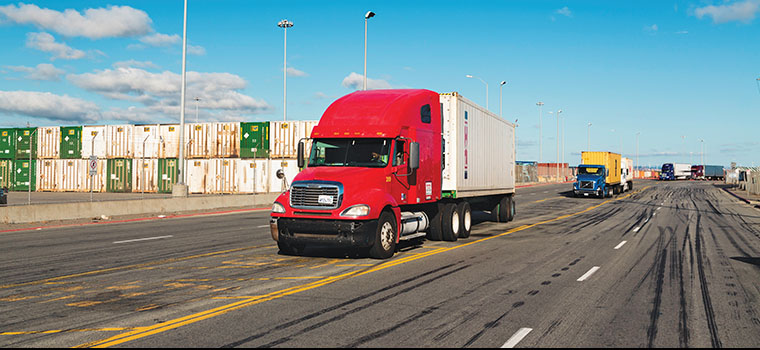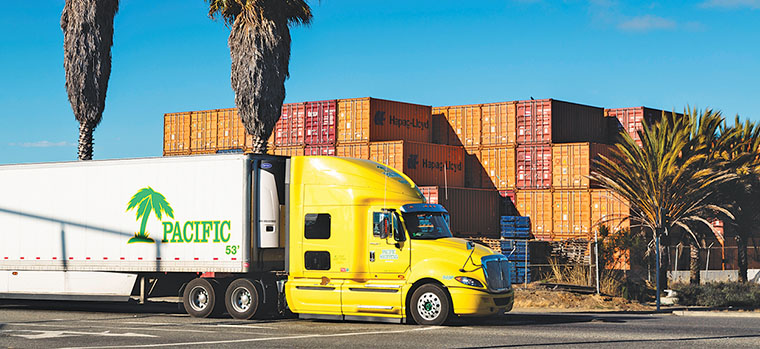The Port of Oakland and City of Oakland have invited the port's neighbors to help shape a new plan for managing truck traffic in the West Oakland area.

The Port of Oakland and City of Oakland are working with the port’s neighbors to help shape a new plan for managing truck traffic in the West Oakland area. Some of the problems being addressed are diesel exhaust, noise and truckers parking in front of homes. Photo courtesy of Port of Oakland
BY BILL PICTURE
Published: December, 2017
The Port of Oakland and City of Oakland have invited the port’s neighbors to help shape a new plan for managing truck traffic in the West Oakland area. About 100 West Oakland residents turned out recently for the first of five scheduled community workshops.
The various effects of truck traffic on the neighborhood—such as diesel exhaust, and truckers parking in front of homes to catch some shuteye—were discussed at that meeting. Also discussed were ideas to make it easier for drivers to stick to the designated truck routes created by the city in 2005 to keep big rigs off residential streets. A new truck management plan is expected to be unveiled next summer.
“This will be a plan that relies on community input to address truck circulation and parking,” said Patricia McGowan, a senior planner at the City of Oakland Planning and Building Department, in a written statement. “We want trucks to be less disruptive by controlling where they drive and where they park.”
Richard Sinkoff, the Port of Oakland’s director of environmental programs and planning, said the city and port have been working together on the update to the existing West Oakland Truck Management Plan for some time.
“It’s part of our ongoing growth strategy to expand business at the port while minimizing community impacts, such as trucks parking in residential areas and air pollution from diesel exhaust,” he said.
More business, more trucks?
September and October were two of the busiest months on record at the port; and import volume for the first 10 months of 2017 was up more than four percent over last year. Logically, this growth could mean an increase in the number of trucks carrying containers to and from the port—now roughly 3,000 on an average day. But the port has a plan.
The port’s strategy for curbing truck traffic is to invest in the infrastructure necessary to reduce manufacturers’ and growers’ reliance on truck transport. A phased expansion of the near-dock rail facility that opened last year on the site of the former Oakland Army Base, as well as plans to establish warehouse facilities and distribution centers on port property, mean products won’t have to travel as many miles by truck.
“This is part of the port’s long-term plan to shift more cargo movement onto rail, and to handle more cargo within the port rather than at remote transfer warehouses in the Central Valley,” said Sinkoff.
For the trucks that will continue to service the port, two service centers are already being planned—one on port property and one as part of the city’s larger development plan for port-adjacent property. At these service centers, drivers will be able to find convenient fuel, food and repair services, restrooms and overnight parking—the very things that drivers stray from the truck routes hoping to find.
“The large majority of truckers who move goods to and from the Port of Oakland abide by the rules,” said port spokesperson Marilyn Sandifur.
Sandifur believes it’s because of the port’s direct access to Interstates 80 and 880 that truck traffic on West Oakland streets has declined significantly in recent years. “Most truck drivers utilize these convenient freeways,” she said.
While trucks found on residential streets can be cited, enforcement has proven a challenge. Police simply have bigger fish to fry. Stricter enforcement was one of the suggestions made at the October meeting, as was better truck route signage to help new drivers and those less familiar with the Bay Area stay out of neighborhoods that don’t want them. Sinkoff believes it’s possible some drivers simply aren’t aware of the routes, so outreach to the Bay Area’s trucking community and industry would be helpful.
Not on my street!
Enough people have complained over the years about drivers sleeping in trucks outside their homes to warrant a closer (and ongoing) examination of the issue by the city and the port. The City of Oakland has established a hotline that residents can call to report chronic truck parking in their area; the port, for its part, conducts a yearly study to find out exactly where port-servicing drivers are parking their rigs at night.
“It is less of a problem than we initially thought,” Sinkoff said. “Our most recent study, in June 2017, indicates very few port-related trucks are parking on residential streets.” He credits that fact to the acres of new truck parking already available at the port.
While it would be easy to blame the problems raised by port neighbors on irresponsible drivers, Sinkoff said the port and the city share equally the responsibility for keeping trucks off residential streets. “We must first develop workable regulations, and enforce them. We must also provide services and port access that truck drivers need to do their job efficiently. Then it’s up to the drivers to follow the rules.”
The next community workshop is scheduled for later this month, and Sinkoff said he’s excited to see what the port’s neighbors bring to the table, as community input has proven to be a key element in the shaping of port policy.
“Community members are able to spot issues that port staff might not see,” he said. “And we rely upon our ongoing dialogue to improve conditions for all Oaklanders. The community certainly expects us to operate in the most responsible manner possible, and we feel that we benefit from the community’s ideas and perspectives.”

Two service centers are already being planned for the trucks that service the port. These locations will provide convenient fuel, food and repair services, restrooms and overnight parking—the very things that drivers stray from the truck routes hoping to find. Photo courtesy of Port of Oakland

